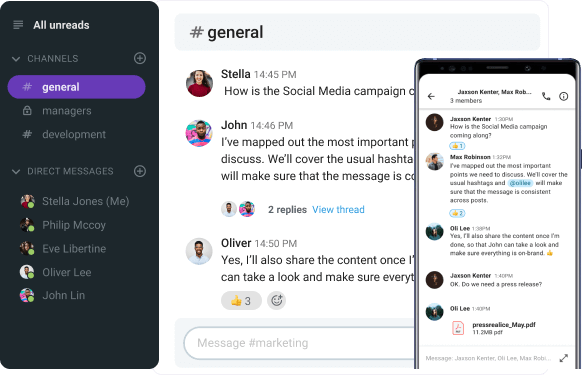During the Great Resignation times, many organizations have become aware that they should invest much more effort in creating good working conditions.
Ping-pong tables and fully stocked pantries aren’t enough anymore to make people think they’re spending time in a positive work environment.
We have asked the professionals what they think is needed to preserve the quality working environment and found answers to the following questions:
- What exactly constitutes a positive work environment?
- What are the characteristics of a good work environment?
- How to create a positive culture in the workplace?
- How does it translate into the remote and hybrid work models?
- What are the key advantages of a pleasant work environment?
So, let’s dive in.

- Positive work environment implies supportiveness, recognition, flexibility, and direct communication.
- In a friendly work environment, people are encouraged to learn and grow.
- Healthy work environment fosters productivity and creativity, which consequently leads to better team performance.
- To make a positive workplace, it’s important to create a friendly atmosphere and promote a culture of belonging, while making employees feel recognized and appreciated for their behavior and results.
Table of Contents
What is a positive work environment?
A positive work environment in a traditional setting refers to a workplace where employees feel excited, happy, and empowered to do their best work.
It’s a place where people feel professionally, emotionally, and physically safe and supported.
The same rules that apply to on-site apply to remote work environments, as well.
People need to feel valued and satisfied for doing their work, even if they work from the comfort of their own homes or coworking spaces.
In any case, it is up to management to create a friendly work environment regardless of where you work.
Before we get to the examples of positive and friendly working environments, let’s see some of their most prominent characteristics.
Positive work environment characteristics
Positive work environment consists of the following characteristics:
- Stress-free and friendly atmosphere,
- Supportiveness,
- Flexibility,
- Direct communication, and
- Employee engagement.
A Transformational Speaker, Workplace Well-Being Expert and Co-Founder at Shift of Play — Corean Canty — explains this further:

“The main quality of a positive work environment is building a culture where both the business and the humans powering it thrive.
This means the culture needs to feel safe for employees to be who they are and there needs to be a sense of connection and community. Employees need to feel like they matter, have room to grow and can integrate their work and greater life needs.”
Let’s learn more about each characteristic.
Stress-free and friendly atmosphere
As soon as employees enter the workplace or log in to their company’s working space, they should feel relaxed but still ready to accomplish every task ahead of them.
In such a work environment, employees are more likely to unleash their creativity and go the extra mile, which reflects on their productivity and overall team performance.
Friendly colleagues and atmosphere should only boost their morale.

💡 PUMBLE PRO TIP
To learn more what boosts team performance and what make teams perform poorly, make sure to check out our articles:
Supportiveness
In a healthy work environment, people push each other to be better.
When employees feel the presence of camaraderie in the workplace, that means they are in one happy, conducive working environment.
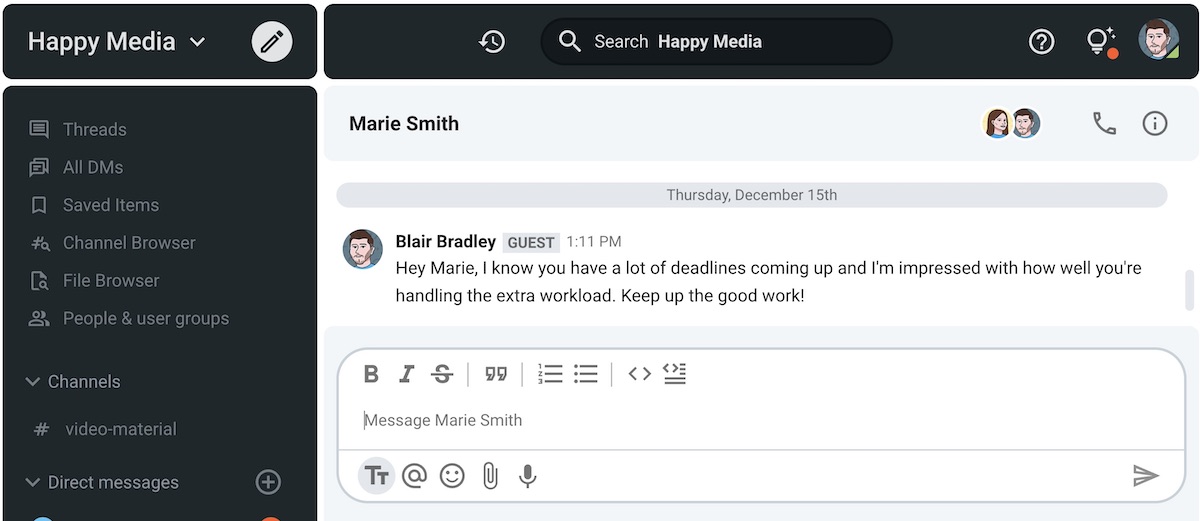
Flexibility
As American author John Maxwell said, “Change is inevitable, growth is optional.”
Companies need to adapt to constant changes and understand the needs of their employees. If their employees are satisfied due to the company’s flexibility, the atmosphere in the team would be positive too.
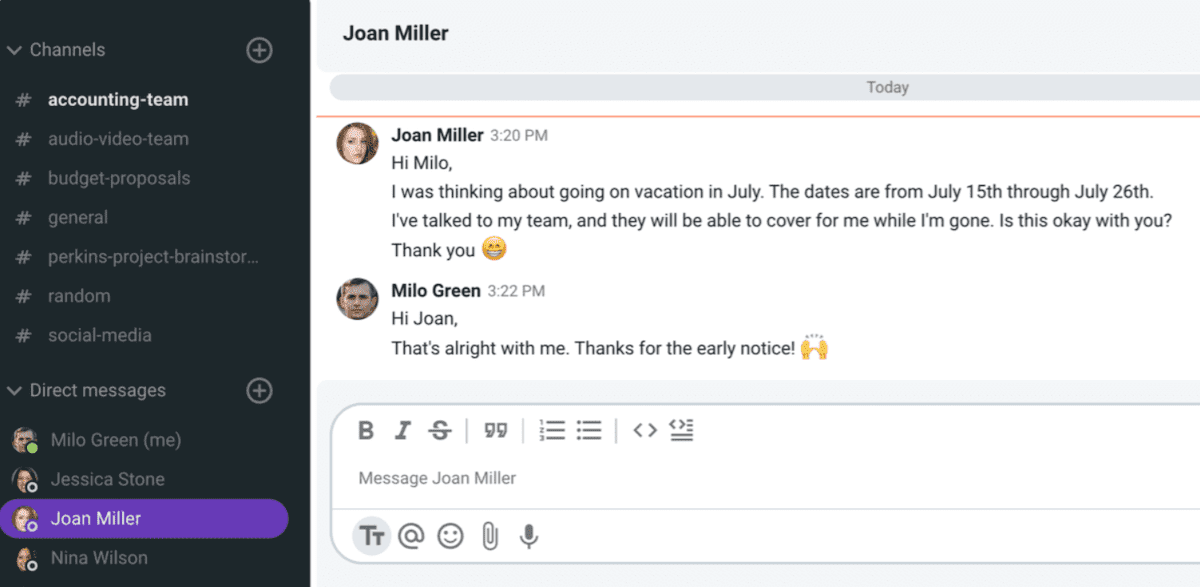
Direct communication
As long as there are no hidden catches and revenge games in a team, a positive atmosphere can thrive.
Therefore, to preserve a conducive working environment, speak up and speak directly.
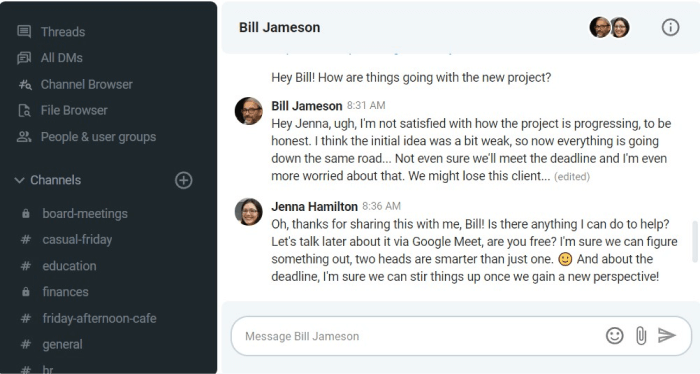
💡 PUMBLE PRO TIP
To learn more about the importance of direct communication, take a look at our article:
Employee recognition
To create and maintain a positive work environment, it’s important to show appreciation for employees’ contributions.
According to a Harvard Business Review’s article, recognition fosters employee engagement and provides a morale boost.
Naturally, when people feel valued and appreciated for their effort and accomplishments, their level of enthusiasm and dedication toward their job is only going to increase.
Simultaneously, productivity gets higher as well as the sense of belonging to the organization. This then takes on a snowball effect of affecting the entire organization and company culture.
We spoke with Sean Stewart, a Leadership Coach and a Business Consultant, who has more than 20 years of global consulting experience in both corporate and non-corporate environments.
He confirmed that employee recognition is essential for making a sustainable positive work environment.

“Maintaining a positive work culture comes down to making sure that the team members are both contributing meaningfully to the success of the team and are recognised for doing so.”
9 tips for creating a good work environment
Contrary to popular belief, facilitating and maintaining a positive work environment is a rather simple endeavor.
All it takes is:
- Being open to understanding employee needs and
- Designing a culture and environment that supports their best interests and well-being.
Let’s go over a detailed process of creating a positive work environment.
Tip #1: Provide extensive onboarding and training
To create a more positive work environment, start from the beginning of the employee journey.
Show support from day one.
Companies that invest considerable time to welcome, inform, and help employees integrate into the organization create an environment where employees feel supported and safe.
According to an Impacting Education’s article, extended onboarding contributes to long-term engagement and retention.
No matter how exciting, the new beginnings can be nerve-wracking for the employees, so provide enough resources and guidance to help them ease into the new environment.
Here are some ideas on how you can support your new employees.
- Offer plenty of information before their first work day. It will help them feel better prepared for what’s to come and reduce the fear of the unknown.
- Dedicate the first 2 weeks for training, socializing, and introducing your new workforce to your community and organizational processes and mission.
- Assign some of the more experienced employees to be their work buddy who will introduce them to company better,
- Allow access to documents outlining key processes, the code of conduct, and the company’s structure.
- Schedule regular check-ins to better support your employees and understand their needs, challenges, and expectations.
- Introduce the new employees to team collaboration apps, such as Pumble, and familiarize them with the company’s chat etiquette.
After going through all these steps, the new employee will feel more comfortable, and the new beginning will be much less stressful.
Most importantly, they would feel ready for the challenges ahead.
💡 PUMBLE PRO TIP
Onboarding in a virtual setting might be more challenging for companies that have never before adopted a hybrid or remote work model.
To learn more about virtual onboarding, check out the following blog post:
Tip #2: Highlight the company mission
Highlighting a clear direction plays a lion’s share in building a positive and motivating work environment.
Your company’s mission and vision statements are powerful, uplifting messages people can reference from time to time.
Their real value lies in empowering and guiding people to put their best foot forward to achieve company objectives. Mission adds meaning to everyday work and allows employees to keep moving forward when facing challenges.
We reached out to Bill Catlette, a Partner at Contented Cow Partners (Leadership and Workforce Advisors), and asked for his expert opinion on the topic of building a positive work environment.
He highlights the company mission as one of the key elements of a positive work environment:

“One of the chief ingredients to a great, productive work environment is the work itself, more specifically, the mission. People want to read mysteries, not live them. Where are we headed? Why, and to whom does it matter? Absent real clarity on this last item, people will conclude that what they are doing all day long doesn’t matter very much, and a decline in their spirit and motivation will be imminent.”
💡 PUMBLE PRO TIP
Transparent communication is essential for a healthy work environment. It boosts engagement and builds trust. To learn more about why transparency is important for communicating mission and how it affects a positive work environment, check out this blog post:
Tip #3: Optimize the work environment for comfort
When considering different ways to create a positive and productive work environment, organizations need to consider how the physical components of space and equipment affect how employees feel.
A great work environment provides optimum comfort and fosters focus and productivity. The pandemic and the global shift to remote work brought this aspect to the forefront.
As the employees were allowed to design their own home offices, it allowed them to understand better how the space and the equipment affect their overall productivity and well-being.
The study about the impact on office worker productivity during COVID-19 shows that employees with spaces dedicated to work in their homes had much higher productivity rates than those who didn’t have it during COVID-19.
The experience from the COVID-19 pandemic paved the way for organizations to understand the importance of employees’ physical and mental well-being — both on-site and remote.
Hence, here are some suggestions that might contribute to the greater comfort of employees.
- Provide ergonomic office chairs for each employee. They ensure optimum back and spine support. This is essential for employees who sit at their desks for long periods.
- Furnish the office with adjustable desks with enough space to accommodate different requirements based on the people’s job requirements and needs.
- Finally, create the perfect layout that aligns with the team and work structure. Also, create enough space for pauses during which employees can recharge and relax.
If you really want to make a difference in your employee’s work environment, consider adding equipment expenses to your regular budget for both remote and in-office staff.
Designing a comfortable and distraction-free space where people can focus on doing their best work is one of the critical steps in creating a positive work environment in which people would love to spend time.
Tip #4: Promote a culture of belonging
To better connect to the all-encompassing mission, people need to feel they belong to a community that shares similar values.
We spend great portions of our time working. Therefore, the relationships with the people we work with present one of the key aspects of how we perceive our work environment.
To create a strong and unified workforce, organizations must facilitate a culture of respect and kindness to foster better relationships and support among coworkers.
To learn more about employees and their expectations, we recommend organizing:
- One-on-one check-ins,
- Regular feedback sessions, and
- Simple, occasional chats.
These icebreakers are great for the beginning. However, to make employees feel like the real part of the group, it would be best to encourage them to bond with their colleagues organically.
Now you might ask, what does this “organically” mean?
Well, instead of pressuring your new employees or colleagues to catch up or share ideas with the rest of the team, allow them to observe how communication within the company works.
Of course, give them some clear directions and explain to them which channels serve for particular types of communication.
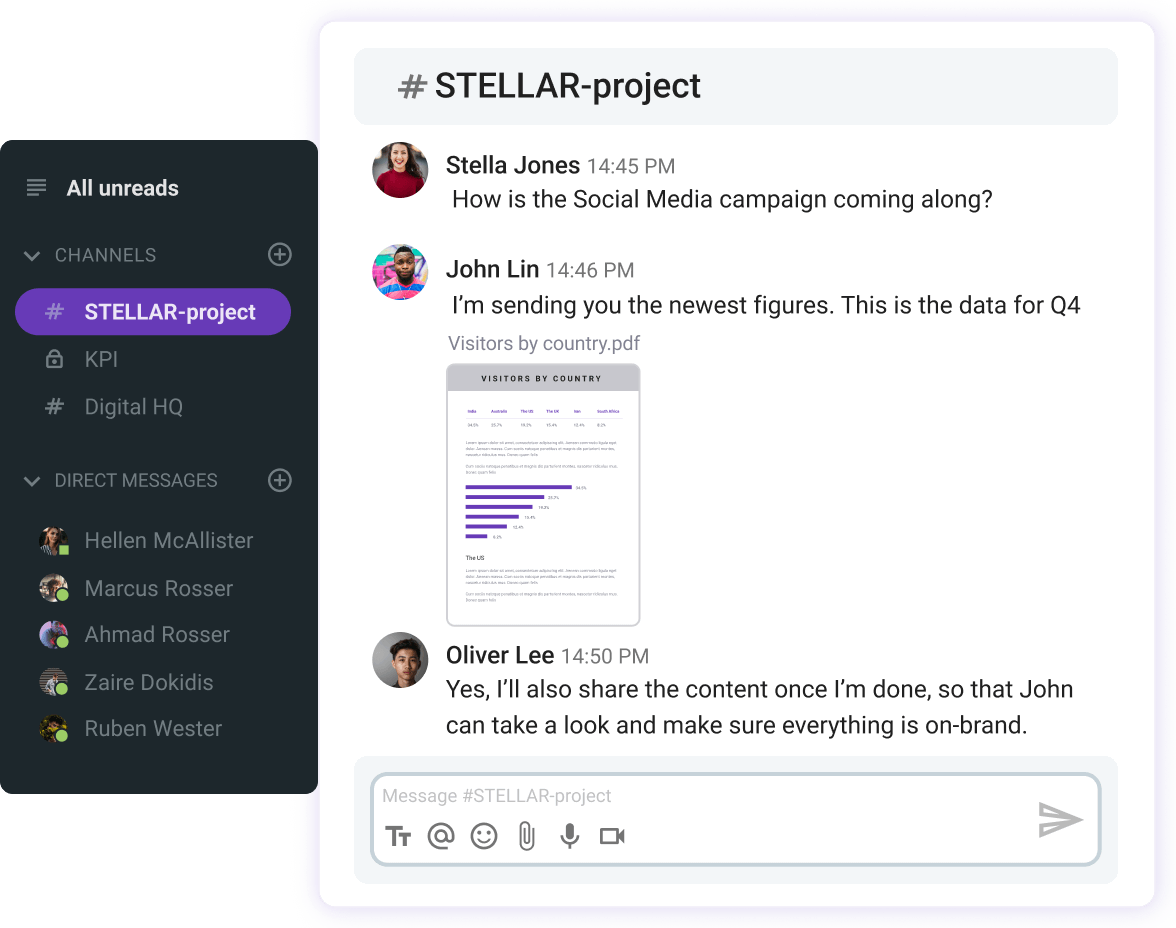
For example, many companies have team communication apps with channels dedicated to project discussions and others for informal chats.
After some time, new employees will start to post or ask questions in relevant channels, and that will attract people of similar interest to the discussion.
This way, you’re allowing people to bond over shared interests or, in other words — bond organically.
Another way to promote a sense of belonging across your organization is to organize live informal gatherings, team-building events, and retreats.
When people are allowed to relax and show their true personalities, they are more likely to form stronger bonds and connect.
💡 PUMBLE PRO TIP
Diversity, equity, and inclusion in workplace communication plays an important role for promoting a culture of belonging. To learn more about why DEI is critical in the workplace and how to embrace it, make sure to read our blog post:
Tip #5: Offer flexibility
Flexible work schedules and environments have become staples of the post-pandemic business world — so much that 66% of employees report they would look for new job opportunities, should their current employer take flexibility off the table.
People have grown accustomed to fitting their work hours around their family arrangements, and the work-from-anywhere model offers plenty of flexibility and freedom in terms of choosing the spaces and locations people work from.
To continue the positive trend across fully on-site and hybrid arrangements, organizations should rethink the way they promote optimal work-life balance for employees.
We spoke with Jason Palmer, CEO and Co-Founder at Bear Claw ATS, and asked for his perspective.
He agrees that nowadays employees value flexibility more than ever:

“Flexibility offers the opportunity for a real work-life balance. This, especially in recent times, is of the utmost importance to employees. People are really prioritizing life outside of work more now than ever.”
Our contributor also claims that granting flexibility to employees is the key to creating a positive work environment, especially in today’s climate:

“Showing current and future employees that companies can be understanding and accommodating on an individual basis regardless of scale, within reason, is of the utmost importance. Employees need choices about how to live their lives, and by giving them that, the company is showing they respect everyone’s individual needs.”
Palmer concludes that, in the long run, offering flexibility can be more fruitful than various other benefits.

“In the grand scheme of things, offering flexibility can be more impactful on a personal level than a few extra days of PTO, a Marginal Bonus, or Traditional Benefits that are already expected by today’s workforce. Giving employees this certain amount of freedom is aligned with the values, needs, and conditioning of people who entered the workforce since COVID started.”
A positive work environment recognizes and supports life outside of work.
Tip #6: Strengthen communication and collaboration
Making your employees feel comfortable and respected is essential when looking to create a positive work environment.
And the key way to achieve this dynamic is through effective communication.
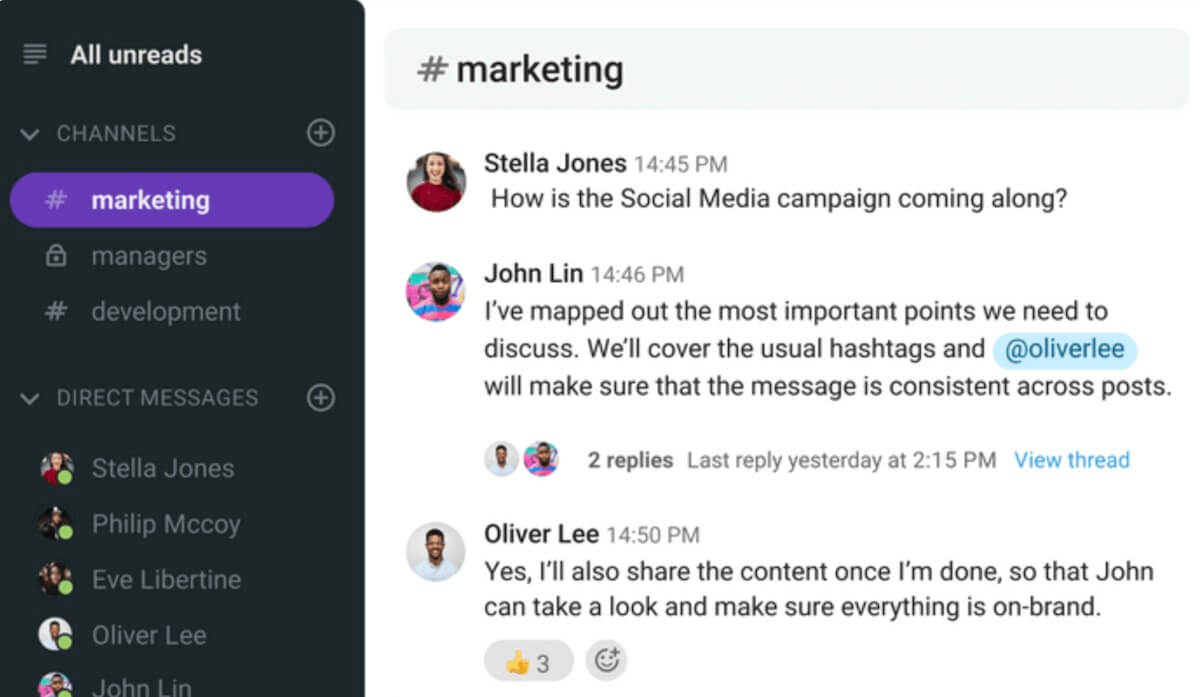
However, you can’t rely on micromanaging to maintain this culture. It’s simply not sustainable nor recommended for managers to personally monitor each individual interaction or decision their team members make.
Instead, consider creating clear communication guidelines and processes that every employee can access and follow. That way, you’re letting the atmosphere naturally unfold within the defined framework without too much interference from higher management.
To structure communications in your team, provide the following:
Element #1: Directions on how to maintain open and clear communication
Detail key values the organization nurtures to make sure your team members align with and understand how to translate these into each communication situation.
Instruct your teams to use simple vocabulary and avoid industry jargon whenever possible.
Role model transparent communication by sharing real-time updates and remembering to give clear and detailed explanations and feedback.
💡 PUMBLE PRO TIP
To learn more about how to improve your professional communication skills, read our article:
Element #2: Effective collaboration instructions
Guide your team’s collaboration by providing clear directions on:
- Goals,
- Team structure,
- The right technology,
- Role division, and
- Responsibilities.
By empowering your team members to work together harmoniously, you’re facilitating a positive work environment where every team member understands their contribution to achieving the overarching vision.
💡 PUMBLE PRO TIP
To learn more about how to improve team collaboration, read our blog post:
Element #3: Guidelines regarding the right tools
Provide clear instructions on which technology is used for:
- Project-specific communication,
- File-sharing,
- Brainstorming,
- One-on-one meetings, or
- Team communication.
Constructive communication and productive team collaboration are the cornerstones of employee job satisfaction. By supporting employees through these key processes, organizations make the biggest positive impact on how their teams perceive their work environment.
Tip #7: Encourage learning and growth
To truly make an impact on your employees’ professional journeys, consider focusing on how you can support their growth with long-term benefits.
We asked Hasnain Malik, the Talent Director of Brainchild Communications, what the key is when creating a positive work environment, and he highlighted growth and learning opportunities as particularly important.

“Align their personal and professional aspirations through the work being given to them. Let them work on tasks they want to and take on challenges they feel excited about.
Give them more flexibility in the shape of maybe longer leaves to rejuvenate. Give them chances to work on organizational-level projects or real-time problems being faced by the organization to make them feel like they are part of the bigger picture of the company.”
While there’s nothing wrong with providing extra PTO days, it doesn’t come close to working in a growth-oriented environment that supports each employee’s individual journeys, preferences, and visions.
Let’s take a closer look at some of the ways organizations can support their employees’ professional development.
Option #1: Skill development
Depending on your resources, you can:
- Organize workshops,
- Provide continual training, and
- Allow access to valuable resources to support your teams’ growth.
By investing in their future, you’re showing your employees that you value their commitment and effort.
Option #2: Promotions
Never let great talent and hard work go unnoticed. Design a clear promotion plan to reward and motivate employees to perform their best and engage in the company mission.
Option #3: Feedback
Regular feedback sessions and performance reviews are a great way to gain more insight into your employees’ individual perceptions of the company culture. In addition, these sessions can also serve as an opportunity to work together on creating a professional development plan that aligns the organization with the personal development goals of employees.

💡 PUMBLE PRO TIP
If you’re unsure how to give constructive feedback in remote setting, make sure to read our blog post:
Tip #8: Listen to your employees
Aside from providing your employees with regular feedback, it’s also important to ask them for feedback consistently and actively listen to it.
This way, you create psychological safety in the workplace, where everyone’s voice is heard – and, consequently, make employees more motivated and engaged.
Tip #9: Prioritize employee recognition
By making your employees feel valued, you’re creating a culture where people feel motivated to do their best job and have fun in the process.
Our contributor, Sean Stewart, highlights that leaders play critical roles in creating positive work environments by acknowledging their employees.

“The recognition of mattering, and the role of the leader in making sure that people do work that matters, is really vital and yet underrated.
The idea here is to move the spotlight away from just remuneration or other similar benefits (which do matter, of course) as being the prime motivator of success and positive environments, and shifting to a place where making contributions and being recognised for that drives positivity and hence success.”
However, it’s important to understand your organization and the people working in it, before you can start making assumptions about which method of employee recognition to use.

“So, leaders have a responsibility to make sure that:
- Praise,
- Feedback, and
- Support
exist in ways that have meaning to the team members.
This will almost automatically help create a positive work environment.”
Therefore, you should tailor your approach to employee recognition considering the employees’ perception of value and the context.
Make sure that the reward matches the accomplishment. A simple “Good job!” in your team chat may not always be the most adequate form of praise, especially when it comes to huge accomplishments that provide massive long-term returns for the company.
To mark a successful project launch, treat your employees to a weekend getaway, a lunch, or a set of tickets to an event you know they’ll enjoy.
To honor entire teams, organize fun team-building/bonding events.
💡 PUMBLE PRO TIP
To learn more about proper employee recognition, check you the following article:
Key benefits of a positive work environment
A healthy and supportive work environment boosts employee engagement.
Furthermore, it creates a complete set of advantages that benefit employee experience and overall organizational effectiveness.
Now, let’s see why a pleasant work environment is paramount to achieving a healthy and productive workplace culture.
Benefit #1: Positive work environment improves employee retention and company profit
It’s not necessarily a groundbreaking discovery to connect employee retention and company profit to a positive work environment.
When professionals feel respected, supported, and cared for, they are naturally more likely to commit to an organization and align with the values it promotes.
Conversely, when organizations fail to create a great employee experience through a positive work environment, it breeds toxic workplace behaviors.
Left unattended, negative behaviors and toxic workplace culture ultimately lead to an increase in employee turnover and cost companies substantial resources.
Benefit #2: Positive work environment drives productivity
Workers who experience higher levels of job satisfaction are more likely to show higher engagement and feel more committed to achieving company goals.
A workplace culture that nurtures positive attitudes and behaviors naturally causes employees to perform their best by fostering strong connections with the company’s mission and vision.
Ample research in business and management literature suggest there is a link between a positive work environment and increased employee productivity.
One of the studies published in the European Journal of Business and Management — Impact of working environment on employee’s productivity — claims:
“The factors like supervisor support, relation with co-workers, training, and development, attractive and fast incentives and recognition plans, adequate workload at workplace are helpful in developing a working environment that has a positive impact on employee’s level of productivity in the organizations.”
At the same time, a stressful and toxic work environment slows down employee productivity.
For example, a stressed person loses 15–60 minutes of productivity per day.
💡 PUMBLE PRO TIP
Mental well-being at work is important. To preserve it and learn more about it, check out the following article:
Benefit #3: Positive work environment creates a resilient workforce
According to a 2021 SHRM culture report titled The Culture Effect: Why a positive workplace culture is the new currency, more than 90% of people managers believe that positive workplace culture creates resilient employees.
A strong organizational culture is more likely to keep the workforce connected and committed to shared values, even during challenges.
This organically created workforce resiliency allows the teams to
- Survive,
- Thrive, and
- Better adapt during changes.
💡 PUMBLE PRO TIP
Knowing how to communicate with your colleagues or employees during turbulent times is essential. Furthermore, it increases their resilience. Learn more about it here:
Benefit #4: Positive work environment fosters creativity and innovation
According to a McKinsey survey, organizations understand that innovation plays a critical role in overall growth. However, they lack the means to foster it properly.
The numbers reveal that 84% of CEOs cite innovation as the essential factor for growth, but only 6% report being satisfied with the actual execution.
A positive work environment, or more precisely — employee happiness — may be the solution.
Under the right circumstances, happiness is one of the activating mood states most likely to stimulate creativity.
Employees working in a positive work environment are naturally more likely to experience heightened happiness levels.
Elements of a positive work environment that largely contribute to employee satisfaction and happiness are:
- Effective communication,
- A sense of belonging, and
- Support to pursue growth.
They also generate more opportunities for creativity and innovation to flourish.
Examples of quality work environments
When we think about a quality work environment, the first thing that comes to mind is the general atmosphere at the workplace.
People, general culture, and great work relationships are the key elements that contribute to the general atmosphere.
While workplace relationships and culture play a huge part, there’s so much more that goes into a truly positive work environment.
Let’s take a look at some examples of positive work environments and how they affect the overall well-being and productivity of the workforce.
Example #1: A company that ensures flexibility for its employees
Company A operates within a hybrid work model.
It allows flexibility for employees, meaning they can organize their work schedule and environment according to their individual preferences.
The office is a well-lit space equipped with comfortable chairs that provide ample back support, adequate work equipment, and dedicated space for relaxation.
Employees can do their most productive work in the office as the space and atmosphere support better focus.
Since the office is spacious, they have enough room for breaks between challenging tasks.
Most importantly, everyone in the office is supportive and relaxed. They are always there to help their colleagues with whatever they need.
Also, during the breaks, there are always some interesting talks between colleagues that are not strictly about the job.
All this makes professionals enjoy coming to work.
On the other hand, employees can recreate the same positive environment when they decide to work remotely.
Thanks to the flexibility and care of their company, remote workers can count on the entire equipment and expenses provided and reimbursed.
Example #2: A company that tries to understand the needs of its employees
Company B organizes regular check-in meetings to better understand the employees’ needs.
During these short meetings, HR and department managers ask thoughtful questions and show interest in their team members’ mental and physical well-being.
Company B uses this feedback to create programs, workshops, and resources that ensure better employee health.
Employees feel valued, supported, and empowered. Furthermore, they can take better care of their individual needs.
As a result, they are able to achieve even better results thanks to a positive environment that acknowledges their needs.
Foster a positive work environment with Pumble
A great workplace atmosphere, appreciation, effective communication, and meaningful relationships are all key to keeping your top-performing people engaged.
With Pumble ― a team communication app ― you can help new employees integrate into the organization and make them feel more comfortable with a welcome direct message or a public channel announcement.
Plus, you can take advantage of group video calls to hold and record training sessions, and regular onboarding check-ins to show them support from the beginning. Pumble offers unlimited message history, thus allowing you to make all the information a new (or existing) employee might need accessible.
Most importantly, to make employees feel valued and motivated, you can provide regular feedback with one-on-one video calls.
Want to create and maintain a more positive work environment with Pumble? Sign up for free today!

